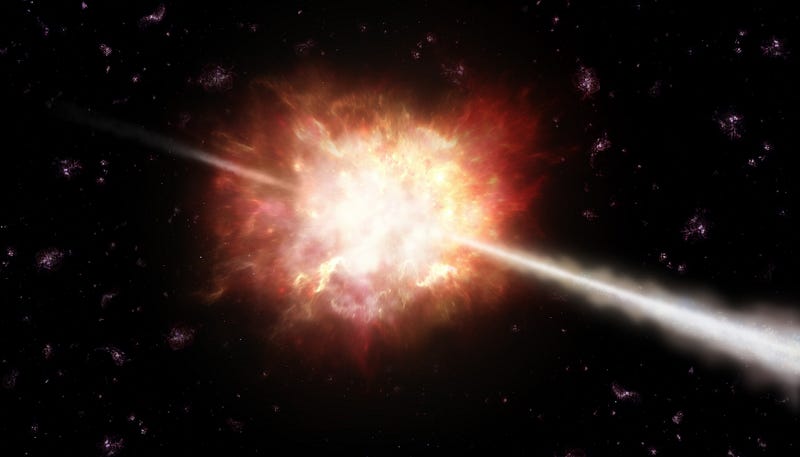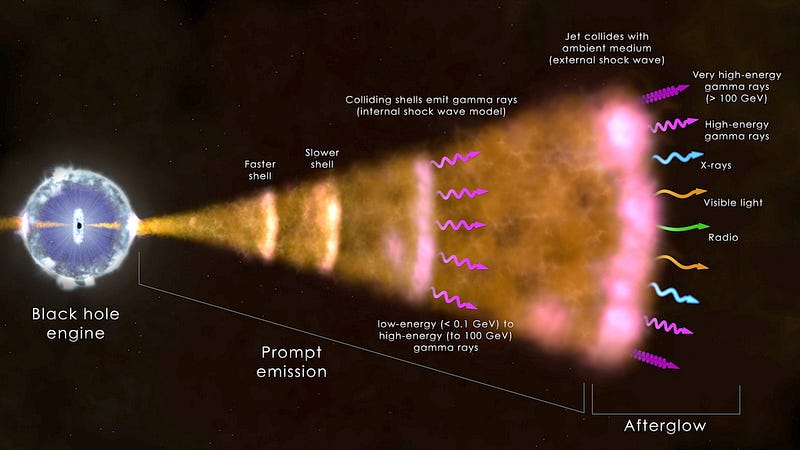Astounding Discovery: The Brightest Gamma-Ray Burst Recorded!
Written on
Chapter 1: A Historic Gamma-Ray Burst
A remarkable cosmic event has been documented—a gamma-ray burst (GRB) of unprecedented brightness! Just a few days ago, observatories worldwide identified an exceptionally intense gamma-ray burst originating from outside our galaxy, likely the most luminous of its kind ever observed.

[Photo: ESO/A. Roquette, CC BY 3.0, via Wikimedia Commons]
The Vela military satellites, launched by the United States in the 1960s, were initially designed to monitor Soviet nuclear activities and ensure compliance with the 1963 treaty prohibiting nuclear tests in the atmosphere, outer space, and underwater.
In 1967, Vela 4 and Vela 3 detected a significant surge in gamma radiation that did not correlate with any nuclear explosion. This data was relayed to scientists at the Los Alamos Scientific Laboratory, prompting further exploration. Enhanced satellites with superior equipment were soon deployed, continuing to capture powerful gamma-ray emissions. Researchers determined these bursts were emanating from beyond our solar system.
The first scientific article addressing what we now recognize as gamma-ray bursts was published in 1973. This milestone marked the acknowledgment of GRBs as the most potent and violent occurrences in the universe.
Section 1.1: The Nature of Gamma Flare Energy
How powerful can a gamma-ray burst be? High-energy gamma radiation is generated by various nuclear reactions and is often linked to nuclear explosions. This ionizing radiation poses significant risks to living organisms; for instance, it is estimated that gamma radiation contributed to the deaths of one in twenty individuals who perished within a month of the Hiroshima bomb.
Typically, cosmic gamma-ray bursts stem from supernovae or hypernovae—massive explosions occurring billions of light-years away. Such events can release energy in mere seconds equivalent to what a star like our Sun would produce over 10 billion years, making GRBs the brightest radiation sources in the universe.

[Photo: NASA/Goddard Space Flight Center/ICRAR., Public domain, via Wikimedia Commons]
Section 1.2: Distance from Earth
Despite their ferocity, there is no cause for concern regarding gamma-ray bursts. Their sources are situated billions of light-years from Earth, well beyond our galaxy. Recently, a gamma flare was successfully documented, being one of the closest events recorded, designated GRB221009A, located merely 2.4 billion light-years away. Remarkably, this flare exhibited gamma photons with an astonishing energy of 18 TeV (tera-electron volts).
Data collection was facilitated by China’s Large High Altitude Air Shower Observatory (LHAASO). If similar findings are confirmed by other research methods, it will represent the first detection of gamma photons exceeding 10 TeV from a flare.
Chapter 2: Investigating the Source of the Burst
The first video, This Gamma-Ray Burst Was the Most Powerful Energy Event Ever Recorded, explores the significance and implications of this extraordinary gamma-ray burst event.
What could have triggered this remarkable flare? While the precise cause remains unclear, evidence suggests a supernova may be involved. Notably, such intense flares can be observed across various spectrums, including radio, visible, and X-ray, enhancing opportunities for data acquisition.
Astronomer Gemma Anderson from Curtin University in Perth remarked on ScienceAlert, “This is an incredibly exciting phenomenon. Its proximity and immense energy make it highly observable. We can study it using both small and large telescopes around the globe, enabling us to gather extensive data on the entire occurrence, from the initial brightening to its eventual decline."
This research could provide insights into the origins of the GRB221009A flare. Furthermore, Anderson adds, “Observing cosmic explosions that eject stellar remnants at near-light speed and leave behind black holes allows us to witness fundamental physics in extreme environments that cannot be replicated on Earth.”
The second video, Record Broken: NASA Just Saw The Biggest Explosion In The Universe So Far, delves deeper into the implications of this cosmic event and its significance in the realm of astrophysics.
Source: ScienceAlert
Atomic Amphibians: The Evolution of Tar-Black Frogs in Chernobyl
Scientists have found that a particular species of amphibians may have rapidly evolved in the exclusion zone surrounding Chernobyl...
Thank you for reading to the end of this article! If you enjoyed it, please consider showing your appreciation by leaving a clap or following me. A tip would also be greatly appreciated—thank you!